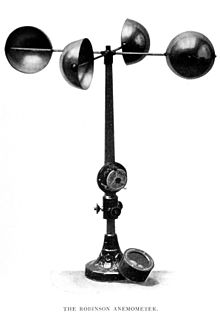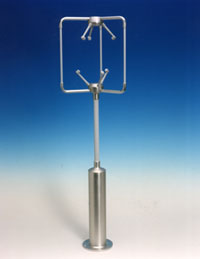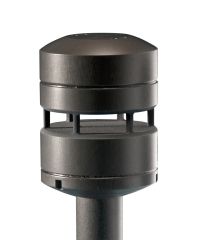Anemometer

As anemometer ( ancient Greek ἄνεμος anemos , German , Wind ' and μέτρον métron , dimension') or anemometer , various measuring instruments for measuring the local velocity of a flow field referred to, in particular the wind speed .
Areas of application
Together with a wind direction transmitter and a recording device, permanently installed anemometers are part of weather stations . Measurement data from temporary systems at the appropriate level are necessary for the selection of the location and design of wind turbines . At larger airfields, the wind measurement data for flight monitoring are usually transmitted from several measuring points. A cup anemometer is often attached to the upper end of the mast of a sailboat , which measures the strength of the apparent wind .
Normally available anemometers are mainly vane anemometers and hot wire anemometers, which can also measure air volume flows and are used to test ventilation systems or for blower door tests .
history
The oldest known anemometer is the wind plate , which is also called plate, vibrating plate, pressure plate or deflection plate anemometer. This instrument was probably invented in 1450 by the Italian architect Leon Battista Alberti and then described by Leonardo da Vinci around 1500 in a sketch based on his own design.
In 1667 the Royal Society in London again mentioned a vibrating plate anemometer. The reinvention is attributed to Robert Hooke . Robert Hooke and Sir Christopher Wren shared an interest in meteorology, both starting their discoveries very early and developing the first thermograph at the age of 15 . In 1663 the apparatus was expanded with a rain and wind meter. Between 1672 and 1678 Hooke added a first vane anemometer to a combined weather recorder he developed. A description of this was published in the Weather Wiser in 1726 . After completing his weather recording device, he worked on the further development of the wing anemometer and in 1683 presented a portable device that could display the number of revolutions and change the angle of the wing to the wind.
After another variant of the vane anemometer by Christian Wolff in 1743, Reinhard Woltman invented a water flow meter with vane in 1790. The instrument had two wings and a revolution counter. It is said that Wolltmann suggested using this as an anemometer.
In 1837, the chief engineer of a French mine, Charles Combes, built an anemometer derived from Wolltmann's water flow meter. This had a protective ring around the impeller and also a rotation counter. Between 1845 and 1862 the measuring device was extended by a switch with which the counter could be coupled in and out. This apparatus was later expanded to include a reset option with which the counter of the counter could be set to zero. This anemometer could be used for wind speeds of 0.4 to 5 m / s, as was required in mine ventilation .
In England they were by Benjamin Biram as Biram's anemometer designated, the 1842 was the first for a patent on this design. They have been manufactured by John Davis in Derby since 1845, and from around 1862 with a circumferential protective ring from Casarelli.
L. Casella of London developed an anemometer around 1870 to measure ventilation in a hospital. This instrument was now able to measure currents from 0.27 to 50 m / s.
Another measuring method with a pitot tube is called Lind's anemometer after James Lind .
The first manometric anemometer, the Lind's anemometer, was described in 1721 by Pierre Daniel Huet , Bishop of Avranches in Normandy, France. The apparatus consisted of a U-tube filled with mercury . One end of the pipe was angled 90 degrees and aligned with the opening facing the wind. The difference in the mercury heights in the U-tube is proportional to the wind pressure and consequently to the square of the flow velocity.
The English pastor Stephen Hales described a similar device in 1743. This apparatus was filled with water and was therefore more sensitive to lower wind speeds.
In 1775, Lind described a pressure pipe anemometer in his work Description and use of a portable windgauge , which was the first practical instrument of its kind.
In 1846 the astronomer Thomas Romney Robinson measured the wind speed using a newly developed anemometer with hemispherical shells. This construction initially only had two such shells, later a further pair of shells was arranged crosswise for the purpose of more even turning force. This type of anemometer is still in use today as a cup anemometer for meteorological measurements. It is probably the most famous type of anemometer.
Types
Windplate
Two well-known designs: vibration plate and deflection plate.
Oscillating plate anemometer: Right-angled plate that is rotatably mounted on its upper edge. Depending on the wind speed, the plate is moved more or less out of its vertical position. The wind speed can be read from the angle on a scale behind the plate.
Deflection plate anemometer, also known as a pressure plate anemometer: Here a plate stands face to face against the wind and is shifted linearly to the wind direction on a slide rail without changing the angle of inclination. A pull rope, which is held taut with a weight by a castor, moves a pointer over a readable scale.
These simple measuring devices can only show the wind speed imprecisely, partly due to the fact that it is in the nature of the wind to rarely flow evenly, partly due to the fact that a moment of inertia prevents an immediate response when the wind plate reacts. In addition, the plate oscillates or swings according to its own laws of gravity or springback - depending on the construction - and then shows deviating results.
Vane anemometer
A vane anemometer is basically a small, almost free-running wind turbine : When the fluid flows through, the rotor rotates just so fast that the usually six to ten steeply inclined blades are almost parallel to the blade surface. The potentially much greater buoyancy only compensates for the flow resistance and the friction of the bearing and possibly a display device. For a low starting resistance, the wheel is very light and the axle is thin; a surrounding cylindrical ring is used for mechanical protection. In modern instruments with an optical or magnetic encoder , the impeller can be smaller (down to 14 mm in diameter), since no counter or eddy current tachometer has to be driven. The speed of the flow to be measured is calculated electronically in modern devices from the angular speed of the impeller, in older devices this was transferred mechanically to a display that is scaled for the information appropriate to the angular speed of the impeller.
Vane anemometers are suitable for measuring weak currents, but because they are idle they can also withstand fast currents and operation in liquids. Hand-held devices can be seen in use in aviation and sailing, in private use, but also in professional use, for example in ventilation and heating technology. Stationary vane anemometers for wind measurement require wind direction tracking . They are better suited than shell anemometers for operation with generator sensors .
Cup anemometer
The cup anemometer , also called cup anemometer , or spherical cup anemometer has a vertical rotor axis - wind direction tracking is superfluous. The speed at which the mostly three hemispherical shells revolve adds up to the wind speed upstream, while the apparent wind is lower downstream. This variation in the flow is compensated for by the directional dependence of the c W value . The fact that the wind both drives and brakes results in a speed that matches the wind. The high speed number is 0.3 to 0.4 depending on the shape of the bowls and, if applicable, the resistance of a display device. Compared to the impeller, the torque does not vary as much with the high speed number, so that the speed reacts less quickly to changes in wind speed.
Inexpensive hand-held devices respond from around 1 m / s ( walking pace ), more expensive ones even at lower speeds.
Dynamic pressure anemometer
A dynamic pressure anemometer measures the pressure difference between total pressure and static pressure. In addition to the static pressure, the total pressure contains the kinetic energy of the flow per unit of volume and occurs when the flow backs up to a standstill. A Prandtl probe , see illustration, has an opening directed against the flow for measuring the total pressure and on its circumference small openings perpendicular to the flow for measuring the static pressure. The pressure difference is recorded or recorded with a differential pressure transducer , previously with a U-tube manometer . displayed. The speed can be inferred from the density . Particularly when used in gases, it must be ensured that the density depends on pressure and temperature, and the hydrostatic pressure can be noticeable in liquids , especially when the probe is accelerated.
Since the kinetic energy depends on the square of the speed, dynamic pressure anemometers are not particularly suitable for measuring small wind speeds. Dynamic pressure anemometers used to be part of the standard equipment of meteorological stations as part of the gust recorder .
Ultrasonic anemometer
Different principles are used in ultrasonic anemometers.
Runtime measurement
Ultrasonic waves are carried along by the medium in which they propagate, so that the transit time of signals over a measuring section of fixed length depends on the flow through the measuring section. Transit times can be determined more precisely with high frequencies (more precisely: with high bandwidth, see pulse compression ) so that high frequencies are used over short distances. Since the speed of sound depends on temperature and humidity, transit times are always determined in both directions. The virtual temperature can also be calculated from the difference in the transit times .
An ultrasonic anemometer usually has several measuring sections between the ultrasonic transmitters or receivers, over which the speed of sound is measured alternately in different spatial directions. Measurement electronics use this to calculate the horizontal and vertical wind speed. Advantages of the ultrasonic anemometer are the higher accuracy, the lack of inertia in the system and the possibility of additional detection of the vertical wind component. The measuring rate depends on the sound propagation time on the measuring sections. With three measuring sections each 20 centimeters long, which are measured one after the other in both directions, the total sound propagation time is around five milliseconds. This means that up to 200 measuring cycles per second are possible.
Acoustic response
A recent development in the field of ultrasonic wind measurement is based on acoustic resonance. While conventional ultrasonic anemometers are based on measuring the transit time, wind sensors with acoustic resonance reflect an ultrasonic wave in a small cavity.
In the cavity there are several vibrating membranes that generate and receive ultrasonic acoustic waves. The repeated reflection between the reflectors creates a quasi-standing wave perpendicular to the wind direction and a transverse wave parallel to the wind direction. If air flows along the axis between the reflectors, this influences the propagation speed of the wave and creates a phase shift that is measured. To compensate for changes in the speed of sound, for example due to changes in temperature, the ultrasonic frequency is continuously adjusted so that the cavity is operated in resonance. This makes the measurement of the air speed independent of the variable speed of sound.
The vector components of the air flow can be determined from successive measurements of different membrane pairs and thus the wind speed and direction can be calculated.
Further principles
In addition to the anemometers already mentioned above, a distinction is made according to the design and the measuring principle:
- Hot wire anemometer (thermal anemometer): In this case, a heating wire is heated and the wind flows around it. In this way, heat is withdrawn from the wire and, with the associated heat loss, conclusions can be drawn about the wind speed. Compared to commercially available vane anemometers, it has a higher sensitivity at low flow velocities.
- The thermoelectric anemometer is a special application in meteorology
- In laser Doppler anemometry (LDA), a stationary interference pattern is built up using laser light from two directions. Particles carried along by currents in fluids scatter the light as they pass through the interference pattern. The intensity of the scattered light is measured and the speed of the flow perpendicular to the strips of the interference pattern is determined from its time course.
- Particle Image Velocimetry
- Surface Pattern Image Velocimetry
- The wind force can be phenomenologically estimated using the Beaufort scale without the use of a measuring device .
See also
Web links
- Description of the development and construction of an ultrasonic anemometer
- Digital anemometer ( Memento from May 11, 2012 in the Internet Archive ) (PDF; 16.6 MB)
- Build your own cup anemometer and use the µController to log, display or connect data to the network
Individual evidence
- ↑ a b Historical anemometers
- ↑ Michael Allaby: Encyclopedia of Weather and Climate . Infobase Publishing, 2002, ISBN 0-8160-4801-0 , p. 27 .
- ↑ Peter Hupfer, Wilhelm Kuttler (ed.): Weather and climate: An introduction to meteorology and climatology. Teubner, Wiesbaden 2006, ISBN 3-8351-0096-3 , p. 182.
- ↑ TJ Ringrose and others: Martian Dust Devil Detection With The Beagle 2 Wind Sensor. (PDF)
- ↑ Patent EP0801311 : Ultrasonic flow velocity sensor and method of measuring the velocity of a fluid flow. Applied on April 9, 1997 , published on March 5, 2003 , applicant: FT Tech LTD [GB], inventor: Kapartis Savvas.
- ↑ Marco Filipponi: The climate of the Schrattenhöhle. ETH, Zurich 2003. doi: 10.3929 / ethz-a-004662252 .








